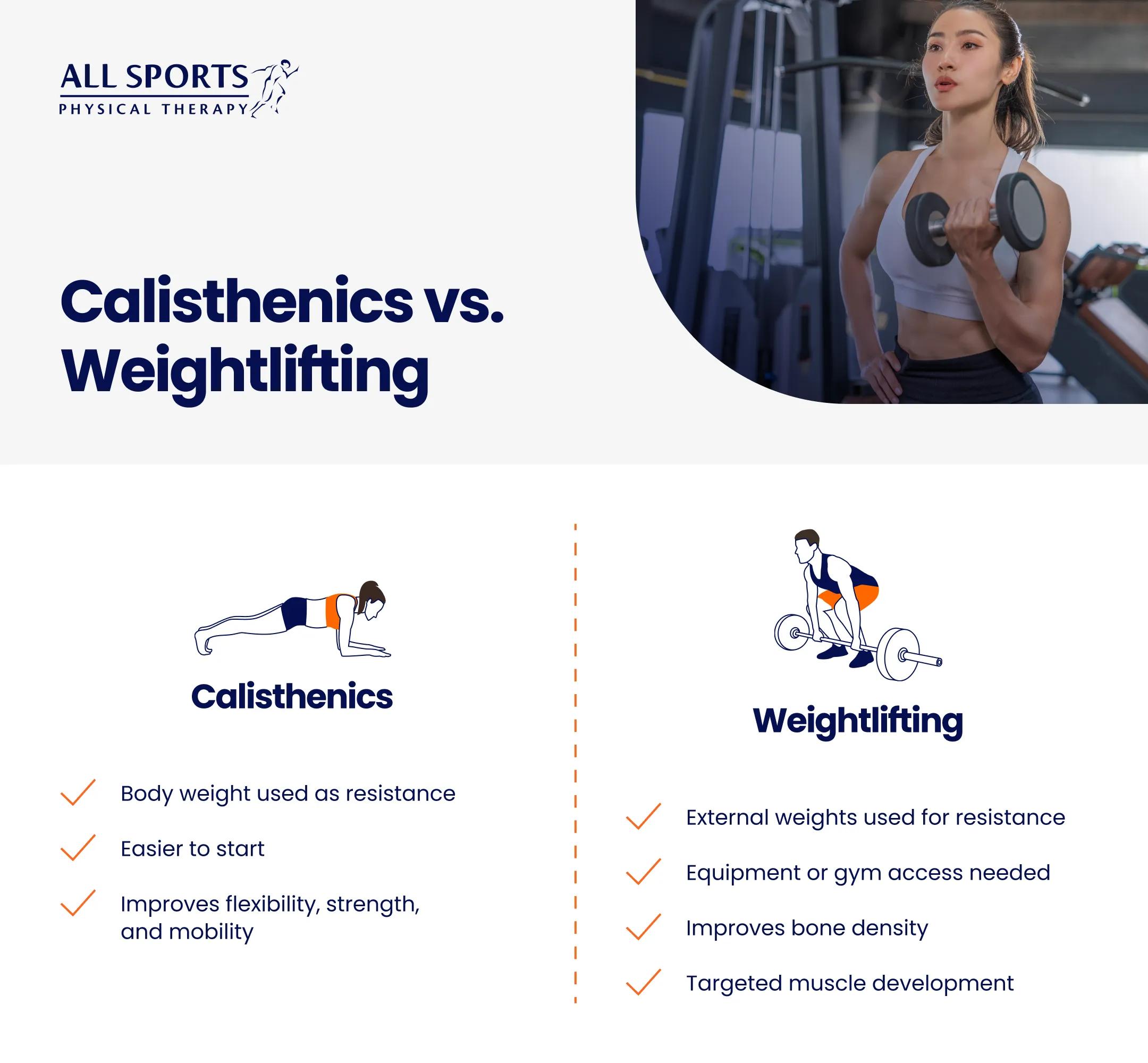Calisthenics vs. Weightlifting: Which is Better?
Sports Medicine

Calisthenics and weightlifting both build strength, but choosing the right one depends on your fitness goals, injury history, and movement needs.
If you're looking to improve your strength, build muscle, or just stay active, you've probably come across two popular training styles: calisthenics and weightlifting. Calisthenics vs. weightlifting is a common debate in the fitness world, as both methods offer unique benefits. While they both help develop strength and endurance, they work your body in different ways.
So, how do you know which one is right for you? As physical therapists, we often get this question from patients who want to build strength safely and effectively. The answer depends on your goals, fitness level, and any existing injuries. Let’s break down calisthenics vs. weightlifting so you can decide which method best suits your body.
What is calisthenics?
Calisthenics is a form of strength training that uses your own body weight as resistance. Think of classic exercises like push-ups, pull-ups, squats, lunges, and planks. These movements challenge multiple muscle groups at once and don’t require equipment, making them a great option for people who want to exercise anywhere — no gym required.
Benefits:
- Easy to start, no equipment needed. You can do calisthenics anywhere, whether at home, in a park, or on the go.
- Improves flexibility and mobility. Since these exercises use full-body movement patterns, they help maintain joint health and range of motion.
- Strengthens core muscles. Many calisthenics exercises engage your core, which is essential for posture and stability.
Potential risks:
- Difficult to progressively overload. Unlike weightlifting, it can be challenging to make exercises harder without adding extra resistance.
- Overuse injuries. Doing high-rep bodyweight exercises with improper form can lead to strain, particularly in the shoulders and wrists.
What about weightlifting?
Weightlifting involves using external resistance — like dumbbells, barbells, or resistance machines — to build strength and muscle. Unlike calisthenics, weightlifting allows for precise control over resistance levels, making it easier to target specific muscle groups.
Benefits:
- Progressive overload. You can gradually increase resistance over time, helping to build muscle strength.
- Improves bone density. Weightlifting puts stress on bones, which helps reduce the risk of osteoporosis as you age.
- More targeted muscle development. If you want to isolate and strengthen specific muscle groups, weightlifting is ideal.
Potential risks:
- Risk of injury from improper form. Lifting too much weight too soon can strain joints and muscles.
- Requires equipment and space. Unlike calisthenics, you typically need access to a gym or weights at home.
Choosing between calisthenics and weightlifting

Choosing between calisthenics vs. weightlifting depends on your fitness goals, experience level, and workout preferences. If you’re recovering from an injury or looking to improve joint stability, flexibility, and overall mobility, calisthenics may be the better option. Bodyweight exercises encourage natural movement patterns, which can help with balance, coordination, and injury prevention — all essential for long-term joint health.
On the other hand, if your goal is to increase muscle mass, improve bone density, or regain strength after an injury, weightlifting allows for more controlled, progressive resistance, making it an excellent tool for rehab and performance training.
Safety tips for both training methods
Whether you choose calisthenics, weightlifting, or a combination of both, here are a few tips to keep your body moving safely:
- Warm up first. A proper warm-up prepares your muscles and joints for exercise, reducing the risk of injury.
- Focus on form. Whether you’re doing a push-up or a deadlift, maintaining proper technique prevents potential injuries.
- Increase intensity gradually. Listen to your body and progress at a steady pace to minimize unnecessary strain.
- Incorporate rest days. Recovery is just as important as the workout itself. Give your muscles time to rebuild.
- Work with a professional. If you’re unsure where to start or dealing with an injury, consulting a physical therapist can help you train safely and effectively.
We’ll help you choose the right regimen
Whether you're looking to improve strength, recover from an injury, or optimize your performance, All Sports Physical Therapy is here to help. Our team specializes in creating customized training and rehab programs tailored to your needs.
Want to make sure you’re training safely and effectively? Schedule a consultation with us today.



